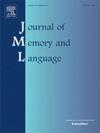番茄-番茄:语音规划中的语音表征与表面特征
IF 3
1区 心理学
Q1 LINGUISTICS
引用次数: 0
摘要
说话者通常会在一个单词与之前发出的单词有相同的初始音段时延长它的持续时间(例如,candy和candle)。对此的一种解释是,具有初始相似性的单词在序列规划过程中会影响语音编码,但尚不清楚这种相似性是语音的还是语音的。我们通过使用一种方言变体来操纵语音差异:美式英语中的pin-pen合并。参与者在三个实验中完成了一个事件描述任务。我们根据参与者的方言来操纵参与者的目标元音([/]或[/])是否与主要说话者的元音在语音上匹配或不匹配。在第二个实验中,我们在启动词([æ]和[æ])中引入了一个控制元音。两个方言组的参与者在目标单词的初始音素相同时都会延长目标单词的长度,即使重叠的初始单词的元音在不同方言中并不相同。在第三个实验中,我们在一个更大的非合并参与者队列中重复了这一发现。所有三个实验都表明,尽管音素的语音实现,单词的长度还是会延长,这表明这种效果是由音位表征而不是表面发音驱动的。本文章由计算机程序翻译,如有差异,请以英文原文为准。
Tomato-tomahto: Phonological representations vs. surface-level features in speech planning
Speakers often lengthen the duration of a word when it shares initial phonological segments with a previously uttered word (e.g., candy and candle). One explanation for this is that words with initial similarity affect phonological encoding during sequence planning, yet it is unclear whether this similarity is phonetic or phonological. We manipulated phonetic differences by using a dialect variant: the pin-pen merger in American English. Participants completed an event description task in three experiments. We manipulated whether the participant’s target vowel ([ɪ] or [ɛ]) either phonetically matched or mismatched the vowel of the prime speaker, depending on the participant’s dialect. In the second experiment, we introduced a control vowel in the prime word ([æ] vs. [ɛ]). Participants in both dialect groups lengthened target words when they shared an initial phoneme, even when the vowel of the overlapping prime word was not shared across dialects. In the third experiment, we replicated this finding in a larger cohort of non-merger participants. All three experiments showed word lengthening despite the phonetic realization of phonemes, suggesting this effect is driven by phonological representations rather than surface-level pronunciations.
求助全文
通过发布文献求助,成功后即可免费获取论文全文。
去求助
来源期刊
CiteScore
8.70
自引率
14.00%
发文量
49
审稿时长
12.7 weeks
期刊介绍:
Articles in the Journal of Memory and Language contribute to the formulation of scientific issues and theories in the areas of memory, language comprehension and production, and cognitive processes. Special emphasis is given to research articles that provide new theoretical insights based on a carefully laid empirical foundation. The journal generally favors articles that provide multiple experiments. In addition, significant theoretical papers without new experimental findings may be published.
The Journal of Memory and Language is a valuable tool for cognitive scientists, including psychologists, linguists, and others interested in memory and learning, language, reading, and speech.
Research Areas include:
• Topics that illuminate aspects of memory or language processing
• Linguistics
• Neuropsychology.

 求助内容:
求助内容: 应助结果提醒方式:
应助结果提醒方式:


